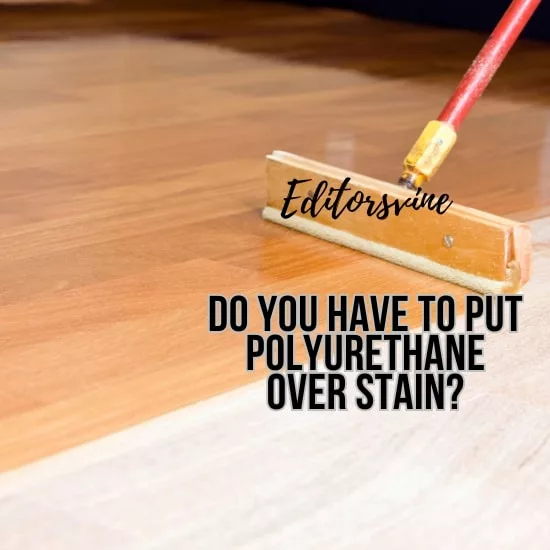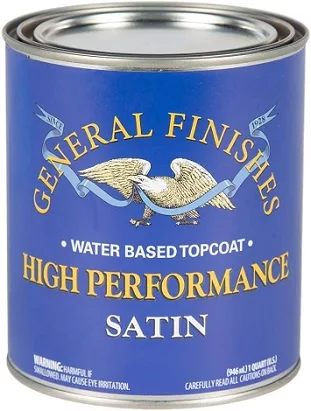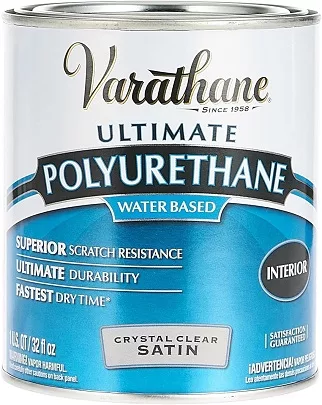
Suppose you want your home to look lavish and aesthetic. At the very beginning, you have to decide on what type of furniture to buy to create this raw look.
So, you go to the internet to look for furniture, and you discover that wooden furniture creates a natural look and is renewable. So, naturally, that appeals to you very much, and you take a fancy to buy hardwood materials for your home.
But There’s A Catch! (As always)
Wooden furniture or hardwood floor needs to be taken care of. It needs perfect furnishing. That’s where stain and polyurethane enter the scene. Now, do you have to put polyurethane over stain?
If you are clueless about how these products work, don’t worry! Let’s get into the depth of stain and polyurethane and hear our insights into whether you have to apply polyurethane over the stain.
How Does Stain Work On Your Wood?
Before anything else, let’s look into why stain is essential for your wood.
Staining wood secures your wooden furniture from water damage. Repairing damaged furniture may cost you a fortune.
However, if you forgo repairing and leave your furniture in a damaged state, it will bring unwanted troubles in the future.
Additionally, stain makes your cherished wooden furniture last longer. It shelters the wood from becoming weak. The stain delves into the depths of the wood and protects it from the inside.
If you want to change the color of your wood, don’t use paint. Paint won’t protect your wood compared to stain.
You can apply the stain after sanding the wood. You’ll get a positive outcome from doing this. Of course, if there is excess stain, you can always wipe it away.
How Does Polyurethane Work On Your Wood?
Polyurethane works as water-resistant to your wood. If poly is coated 3-4 times, you can be assured that the wood won’t discolor and look scratched.
Polyurethane protects the wood and makes the wood look original. It extracts the beauty of wood and embellishes it to look better.
Poly works as superb finalization as it’s more durable than other finishes. In addition, it doesn’t have any hazardous chemicals and protects your wood from sunlight. Hence, it guarantees your safety as well.
Applying polyurethane on your wood as a clear finish is the finest choice you’ll ever make because it lasts for at least 12 months. Therefore, you don’t have to worry about your wood being damaged for a year!
If you put poly on your hardwood material, it will produce a shiny glare on your wood as soon as the poly dries. Moreover, it will protect your wooden material by making it stronger and more resistant.
Another advantage is, poly doesn’t take too much time to cure. Afterwards, you’ll see the positive results you’ve wanted for a long time!
Do You Have To Put Polyurethane Over Stain?
You already gained information about the uses of stain and polyurethane. Now let’s dive into the real question, shall we?
As there are both sides to a coin, applying polyurethane over stain has both advantages and disadvantages.
Let’s look into the advantages first!
Advantages
Protecting Your Wooden Object
Even if a stain protects the wood partially, it isn’t as protective as it should be. It is because stain only changes the color of your wooden material. Therefore, a finish is needed, and polyurethane is the best finish in the market right now!
Safety Concerns
Earlier, you saw that polyurethane secures your wood from dangerous chemicals and UV rays. But, unfortunately, a stain cannot function like that.
To be on the safe side, you may need to apply poly over the stain.
Achieving The Best Results
If you only apply a stain without a sealer, you won’t see your desired positive results. To achieve the best outcome, you must put a polyurethane finish over the stain.
Protective Coating
You already know that after putting on a stain, you have to wipe off any excess. By doing that, you’re not leaving anything behind on your wood.
In addition to that, you have to put a polyurethane finish to protect your wood materials from scratch and damage. Moreover, it puts a stops to the wood from drying out.
Providing Long Term Protection
Previously, we discussed that putting a polyurethane finish keeps you from worrying for about a year.
Only staining wood may give your wooden furniture a rich, raw texture. However, it won’t give you the long-term protection you desire.
Applying polyurethane over the stain will give your wood endurance and durability.
Disadvantages
We talked about the advantages. Now let’s look into why you may not want to put polyurethane over the stain.
Overcritical Finish
Polyurethane comes with a long list of instructions. If you want to apply poly safely, you must go through the instructions carefully.
Some people may find it fussy to follow thoroughly. However, failure to follow the instructions might give rise to safety concerns and trigger health hazards.
The lack of simplicity is a big issue.
Dustless Environment
It’s hard to find a dust-free environment. However, poly demands to be applied during dust-free weather.
Therefore, if you want to put polyurethane finish on your wood, you may need to do that in your own home.
The hassle of finding the ideal place and condition might be burdensome to a lot of people.
Air Bubbles
If you shake a can of polyurethane, it will create air bubbles. The bubbles will damage your material, creating a rutted wood surface.
If you don’t want a rutted surface, you’ll have to sand, which takes more time and effort. You already know that before staining wood, you need to sand. Therefore, you have to apply sand two times if you use polyurethane.
It can be time-consuming and problematic for some.
Crucial Application
While putting the poly, you must pay total concentration to it. This application is complex for some people and takes a great deal of time and effort.
How To Apply Polyurethane Over Stain?
It’s up to you whether you will put poly over the stain or not. But if you decide to implement a polyurethane finish on your wood, here are a few steps to look over.
- You should apply polyurethane with the most delicate quality brush or cloth.
- Firstly, you have to put one thin layer coat onto the surface with the brush. Do not overbrush!
- The first coat takes an average of 2 hours to dry. Afterwards, you have to put the second layer.
- For the oil-based poly, you may have to sand between coats. However, you don’t have to put sand between the layers if you’re using water-based polyurethane.
- At least three and at most four coats of poly are recommended to put over the stain.
- In all cases, you must check the manufacturers’ directions for better knowledge.
What Polyurethane Is The Best To Use?
Here are a few of the finest poly finishes you can apply to your wooden materials.
General Finishes High-Performance Water Based Topcoat, 1 Quart, Satin

This product is highly durable and dries pretty quickly. Additionally, it is one of the most complex coatings to put on wooden objects. It makes applying effortless since you can apply the chemical evenly with a brush or sponge.
Varathane 200241H Water-Based Ultimate Polyurethane, Quart, Satin Finish

This unit provides the user with natural, raw-looking highlights to bring the best out of your furniture. If you want premium protection on your wooden objects, then this is your go-to product.
Minwax 63000 Fast Drying Polyurethane Clear Gloss, Quart

This unit is designed for your interior furniture. It gives an excellent shiny look to your wooden material that will surely attract eyes. Moreover, it is long-lasting, so it won’t make your wood discolored anytime soon!
Final Words
We have come to the end of our discussion on do you have to put polyurethane over stain. However, we have provided ample information and keen insights on thoroughly putting polyurethane over the stain.
There are pros and cons of applying poly over the stain. Now, you may decide whether you will go for the polyurethane finish or settle only with the stain.
After all, you know your furniture more than we do! Go through the instructions above one more time, and if you find more pros than cons, you know what to do!
Lastly, while making decisions, you must keep an eye on the health concerns and choose the option that best serves you, your home, and your furniture.

